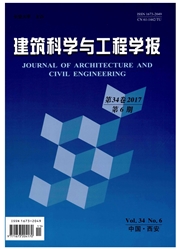

 中文摘要:
中文摘要:
对1座连续梁桥在开放交通下的动响应进行了现场实测和分析。对试验桥的调查、测试和分析主要包括:路面粗糙度实测及功率谱密度分析、自振特性测试与分析、开放交通下的交通荷载观测以及相应的桥梁动位移和加速度实测。为了根据实测桥梁动位移响应确定冲击系数,采用低通Butterworth滤波器对实测动位移响应的动力部分进行滤除而保留了静力极值。此外,研究了冲击系数与车质量、车速之间的关系,采用K—S检验法分别按极值Ⅰ型分布类型对实测冲击系数进行了分布拟合检验,并基于统计方法确定了该桥的冲击系数,最后与各国规范确定的冲击系数进行了对比。结果表明:冲击系数随着车质量的增加而减小,冲击系数随着车速的增加在一个较宽的范围内整体上逐渐增大,实测冲击系数谱基本上服从极值Ⅰ型分布,采用统计方法确定的冲击系数小于很多国家规范确定值。
 英文摘要:
英文摘要:
Field test and analysis were carried out for dynamic responses on a continuous bridge under open traffic. The inspection, testing and analysis for the tested bridge mainly consisted of the measurement of pavement roughness and analysis on power spectral density, the testing and analysis on natural vibration characteristics, the observation of traffic loads under open traffic and the corresponding measurements of dynamic displacement and acceleration on bridge. To determine impact factors in terms of measured dynamic displacement responses, low pass Butterworth filter was used for filtering the dynamic part of measured dynamic displacement and the static extreme values were reserved. In addition, the relations between impact factors and vehicle weights, vehicle speeds were studied, the distribution fit test was performed using K-S methodology for measured impact factors according to extreme-Ⅰ type respectively. Finally, the impact factor of this bridge, which was determined by statistical method, was compared with code specified impact factors of different countries. The results show that impact factor tends to decrease with increasing vehicle weight, and the impact factor increases gradually as the vehicle speed is increased within a wide range, moreover, the measured impact factor spectrum follows extreme I type basically, the impact factor determined by statistical method is smaller than codespecified impact factors of many countries.
 同期刊论文项目
同期刊论文项目
 同项目期刊论文
同项目期刊论文
 期刊信息
期刊信息
